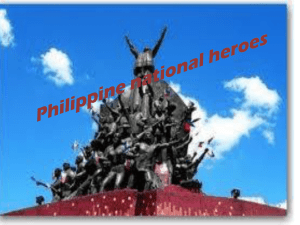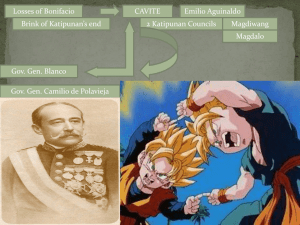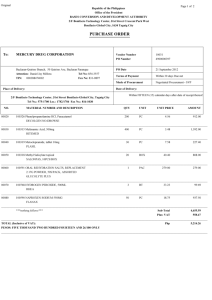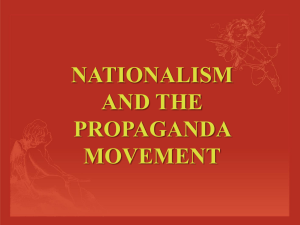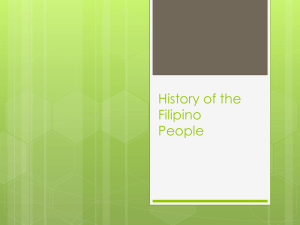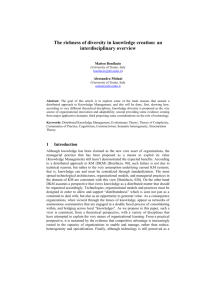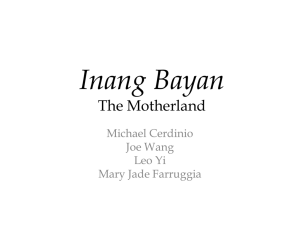Andres Bonifacio: Life and Revolution
advertisement
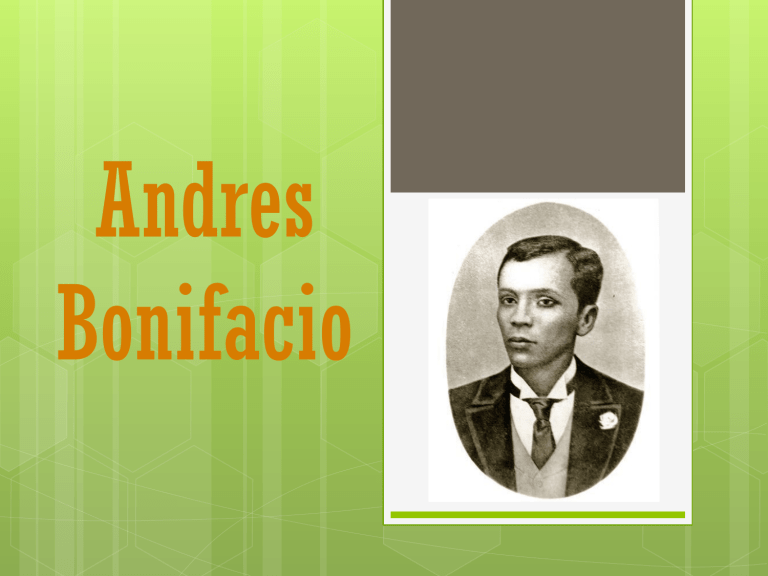
Andres Bonifacio Andrés Bonifacio y de Castro He is a Filipino who was born in Tondo, Manila in November 30,1863. The son of Santiago Bonifacio, a simple official, and Catalina de Castro, a tobacco factory worker. His siblings are Procopio, Espiridiona, Troadio, Maxima and Ciriaco. And Andres is the eldest among them. He grew up in the slums and knew from practical experience the actual conditions of the class struggle in his society. He learned the alphabets from his mother’s sister and eventually began his education at a private school, possibly run by certain Guillermo Osmeña from Cebu. He studied here for seven years only. When Andrés was still very young, his father contracted tuberculosis, which forced him to stop working. He died when Andrés was barely 13. A year later, his mother also passed away from the same disease. After that, it fell upon 14 years old Andrés to look after his younger siblings. In around 1877-1878, Andrés dropped out of school. However, he continued his studies in private, reading books on subjects like French Revolution and biographies of the US Presidents. When he was in his late teens, he also picked up English and read internationally famous works like ‘Les Misérables’ by Victor Hugo, ‘Le Juif errant’ by Eugène Sue and ‘Noli Me Tángere’ and ‘El Filibusterismo’ by José Rizal etc. He also grew an interest in contemporary Philippine penal and civil codes. EARLY CAREER Orphaned early, he interrupted his primary schooling and started working in the age of 14 in order to earn a living. He started making fans out of paper and cane, which he and his siblings sold to sustain themselves. Later, they began making posters for business houses. As a craftsman and then as clerk-messenger and agent of foreign commercial firms in Manila. FAMILY BACKGROUND Andrés Bonifacio was first married to one Monica of Palomar, his neighbor in Tondo. She died of leprosy a year after their marriage. In 1892, 29 years old Bonifacio met 18 years old Gregoria de Jesús. In 1893, they got married at the Binondo Church in a Catholic ceremony. The couple had a son named Andrés, born in early 1896. He died of smallpox when he was still an infant. One of the heroes of the Filipino insurrection against Spain. Early 1890s, he used to distribute revolutionary leaflets against Spanish oppression near the University of Santo Tomas. By 1892, he was fully involved in nationalist movements, becoming one of the cofounders of ‘La Liga Filipina,’ established formally by Jose Rizal on 3rd July. After the group’s first meeting was held, the Spanish authorities arrested Jose Rizal. On July 7 1892, it was announced that he would be deported to Dapitan in Mindanao. ESTABLISHMENT OF KATIPUNAN He founded the Katipunan together with Ladislao Diwa, Teodoro Plata, Deodato Arello, Valentin Diaz and Jose Dizon. Along with cofounding Katipunan, Bonifacio also revived La Liga Filipina. But very soon he severed ties with the latter organization over ideological differences. He started focusing on KKK, which slowly but steadily began to expand by opening chapters in different provinces. Kataastaasan Kagalang-galangang Katipunan ng mga Anak ng Bayan It is a Philippine revolutionary society founded by anti-Spanish colonialism Filipinos in Manila in 1892; its primary goal was to gain independence from Spain through a revolution. The KKK members agreed on the following objectives: ▪ The political goal was to completely separate the Philippines from Spain after declaring the country’s independence. ▪ The moral goal was to teach the Filipinos good manners, cleanliness, hygiene, fine morals, and how to guard themselves against religious fanaticism.. ▪ The civic goal was to encourage Filipinos to help themselves and to defend the poor oppressed. The “Kataastaasang Sanggunian” (supreme council) was the highest governing body of the Katipunan. It was headed by a supremo, or president. Each province had a “Sangguaniang Bayan” (Provincial Council) and each town had a “Sangguniang Balangay” (Popular Council). The Leaders of the Katipunan: ▪ Deodato Arellano -Supremo ▪ Ladislao Diwa -Fiscal ▪ Teodora Plata -Secretary ▪ Valentine Diaz -treasurer ▪ Andres Bonifacio -controller Bonifacio first served as its comptroller and then as its 'fiscal'. Bonifacio would only become Supremo on January 5, 1894, with Santiago (Secretary), Emilio Jacinto (Fiscal), and Molina (Treasurer). Further reorganization in 1896 led to Jacinto becoming Secretary, and Pio Valenzuela becoming Fiscal. The Katipunan expanded from 30 to 30,000 to 400,000. RECRUITMENT METHOD New recruits to the secret society underwent a rigorous initiation process, similar to Masonic practices. (1)in front of a cabinet draped in black. He was then seated at a dimly-lit table, on which rested a bolo (2)a revolver (3)and a set of questions which he must answer to the satisfaction of the members assembled Signing the oath of membership in his own blood, usually drawn from a cut made by a scalpel to the left forearm. The organizational structure of the Katipunan entailed three ranks of membership, with new members starting out as “katipon,” then moving up to “kawal” and eventually to “bayani.” Members were to pay an entrance fee of one real fuerte, a unit of currency equal to 1/8 of a silver real peso, as well as monthly dues and other fees paid exclusively to the Benefit Fund and collected at every session or meeting. Though the organizational structure of the Katipunan was constantly in flux, it is generally believed that they formed small branches, governed by the sangguniang balangay, and these small branches would form larger provincial councils, governed by the sangguniang bayan. All these would be overseen by the Supreme Council of the Katipunan (Kataastasang Sanggunian), which was composed of a president (pangulo), secretary (kalihim), fiscal (tagausig), treasurer (tagaingat yaman), and six councilors (kasanguni). The legislative body of the Katipunan was known as the Katipunan Assembly, and it was composed of the members of the Supreme Council, along with the presidents of the popular and provincial councils. Judicial power rested in the sangguniang hukuman, which were provincial courts that decided on internal matters; however, judgement on grave matters (such as betraying the Katipunan or committing acts penalized by the organization’s laws) were meted by the “Secret Chamber,” composed of Andres Bonifacio, Emilio Jacinto, and Dr. Pio Valenzuela. In March 1896, Katipunan also established its own paper called, Kalayaan (Freedom), with Bonifacio contributing in it under the pseudonym of Agapito Bagumbayan. The paper led to a drastic increase in their membership, which grew from around 300 at the beginning of the year to 3000 by July. On 3 May 1896, Bonifacio held a general meeting in Pasig, where the leaders of Katipunan met to discuss the timing of the revolution. By then, a rebellious mood was sweeping across the nation and Bonifacio and his group believed that the time was right to launch their revolution. Others like Santiago Alvarez and Emilio Aguinaldo believed that they still lacked adequate firearms; and therefore, they should wait. 1896 REVOLUTION A SERIES OF BLOODY REVOLTS Bonifacio simultaneously planned an attack on Manila. However they were caught off guard, as though the revolutionaries were greater in number, the Spanish authorities were more armed. According to historical accounts, Bonifacio continued with his plan despite the failure in his first attempt. The revolt flared up in the surrounding provinces, including Central Luzon, San Juan del Monte and Southern Tagalog (which is why this is also known as the Tagalog War). After several unsuccessful revolts, rebels in Cavite finally had a taste of victory. Under Emilio Aguinaldo (mayor of Cavite El Viejo) and Mariano Alvarez (Bonifacio’s uncle), the Philippine Revolution was in full swing. REVOLUTION BREAKS OUT By August 1996, the Spanish authorities became aware of the presence of a secret seditious society and realized that the country was on the verge of a revolution. On August 19, so as to preempt the uprising, they arrested and imprisoned hundreds of Filipinos, many of whom were not even involved in rebellious activities. In late August 1896, Andrés Bonifacio organized a mass gathering in Caloocan. Here, they kickstarted the revolution by tearing off their personal identity documents or cedulas, signaling their refusal to pay taxes under Spanish rule. The event was later known as the ‘Cry of Balintawak’ or ‘Cry of Pugad Lawin’. Bonifacio then reorganized the Katipunan into an open de facto revolutionary government, naming the nation as ‘Haring Bayang Katagalugan’ or ‘Tagalog Republic’. On August 23, 1896, he declared independence from Spain, naming himself President and Commander-in-Chief of the revolutionary government. On 28 August 1896, he issued a proclamation, calling for "all towns to rise simultaneously and attack Manila”, and sent generals to lead the rebel forces. He himself led an attack on San Juan del Monte with the intention of capturing Manila's metro water station and the powder magazine on August 30. In San Juan del Monte, the Spanish, who were fewer in number, were able to hold off until the reinforcement arrived. Ultimately, Bonifacio’s troops suffered great casualties and he was forced to withdraw. Thereafter, he turned his attention to establishing mountain and hill bases at Balara, Pantayanin, Ugong and Tungko. On November 7, 1986, he led attacks on Marikina, Montalban and San Mateo. Although he initially succeeded in driving away the Spaniards from these towns, he later lost these posts and decided to move to Cavite where troubles were brewing between two groups. CONFLICT WITH EMILIO AGUINALDO The rebels in Cavite were divided into two factions; Magdalo, headed by General Emilio Aguinaldo and Magdiwang, headed by Andrés Bonifacio’s relative Mariano Álvarez. When Bonifacio reached Cavite, Aguinaldo, who was militarily more successful and belonged to a wealthy family, started challenging him on various matters. The first assembly in Imus achieved little. So, they decided to meet in Tejeros on March 22, 1897 and hold an election in order to settle the issue of governance within the Katipunan once-and-for-all. To settle the leadership dispute, the Tejeros Convention was established. This assembly of officials was intended to unite the two factions and elect officers for the revolutionary government. After a makeshift election, Bonifacio lost to Aguinaldo and leadership was turned over to him. Bonifacio was given the role of Director of the Interior, but his qualifications were questioned. Under this further scrutiny he left the assembly – Aguinaldo took oath as President the following day. The election was won by Emilio Aguinaldo, who became the President of the new Philippine republic. Bonifacio received the second highest number of votes, by virtue of which, he should have become the vice president. But he was appointed to the post of Secretary to the Interior, a relatively lower position. Since Bonifacio did not have any university degree, Daniel Tirona questioned his fitness for the job of Secretary to the Interior. Humiliated, Bonifacio pulled out his gun to shoot Tirona, but was stopped. He later dissolved the assembly and declared the result null and void. The arrival of the Americans and the Declaration of Independence April 1898 marked the second phase of the Philippine Revolution. After a US Navy warship exploded and sunk in Havana harbor, the Americans declared a war against Spain known as the Spanish-American War. The US Navy’s Asiatic Squadron, led by Commodore George Dewey, sailed to Manila and defeated the Spanish Navy. In just a few hours all Spanish ships were destroyed and the US gained control of the Philippine capital. And on June 12, 1898, Aguinaldo declared the country’s independence and the birth of the Philippine Republic. From his balcony in his house in Kawit, Cavite, the Philippine flag was unfurled. The Philippines’ National Anthem, “Lupang Hinirang” was first heard by the Filipino people. By April 1897, Emilio Aguinaldo had consolidated his position, with many of Andrés Bonifacio’s supporters switching sides. Sensing trouble, Bonifacio decided to get out of Cavite. He therefore left for Indang on his way to Morong. While he was in Indang, Aguinaldo issued an arrest warrant for him, accusing him of fostering disunity and sedition. According to some sources, he also received complaint that Bonifacio’s troops had stolen work animals and burned down a village because the villagers refused to provide provisions. On April 25, 1897, while he was camping at barrio Limbon, Indang, Bonifacio was surprised to see Aguinaldo's men led by Colonel Agapito Bonzón and Major José Ignacio Paua coming to visit them. He did not suspect anything and received them cordially. The day passed peacefully. Early on April 26, 1897, Bonzón and Paua opened fire on Bonifacio's men. Although surprised, Bonifacio told his men not to fight against their own people. But shots were nevertheless exchanged. One of his brothers was killed while another was beaten and his wife was raped. o Bonifacio was shot in the arm by Bonzón and stabled in the neck by Paua. He survived only because one of his men prevented Paua from striking again, sacrificing himself in the process. He was then taken to President Aguinaldo’s headquarters in Naic along with other captives. TRIAL AND EXECUTION At Naic, Andrés Bonifacio and his brother Procopio were tried for treason and sedition against the revolutionary government as well as for attempting to murder Aguinaldo. The jury was composed entirely of Aguinaldo’s men. So was his defense lawyer, who acted more like the prosecutor. As Bonifacio’s trial started, his defense lawyer, instead of defending him, confirmed his guilt. Bonifacio was not allowed to confront the witnesses. Therefore, in spite of insufficient proof of his guilt, he and his brother were sentenced to death by a firing squad. On 8 May 1897, President Aguinaldo commuted the death sentence into deportation to an isolated island nearby. But on being persuaded by his generals to withdraw the order, he ultimately signed the death sentence. On May 10, 1897, the Bonifacio brothers were taken to Mount Nagpatong, near Mount Buntis in Maragondon, where they were shot dead by a firing squad. At that time, Andrés Bonifacio was 34 years old. THANK YOU! Ma’am Deng, Ma’am we just want to inform you that the other informations about Andres Bonifacio are not included in our presentation for we will provide it as supplement during the actual reporting. Thank you! MEMBERS Cheska Faye Cordero Yves Laurent Ventican Keith Mortera Eva Jane Sagadraca Keiryll Jon Baliuag Matthew Robles
